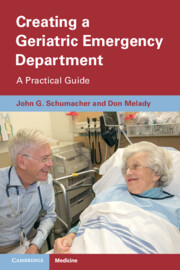Book contents
- Creating a Geriatric Emergency Department
- Creating a Geriatric Emergency Department
- Copyright page
- Dedication
- Contents
- Acknowledgments
- Introduction
- Chapter 1 Making the Case for a Geriatric Emergency Department
- Chapter 2 Starting a Geriatric Emergency Department
- Chapter 3 Overcoming Resistance: What to Do with “Yeah, But…”
- Chapter 4 You: An Approach to Your Older Emergency Department Patients
- Chapter 5 People: Adding Staffing and Training
- Chapter 6 Processes: Implementing Protocols and Policies
- Chapter 7 Place: Addressing the Physical Environment
- Chapter 8 Quality Improvement in the Geriatric Emergency Department: Getting Started
- Chapter 9 Launching Your Geriatric Emergency Department: From First Steps to Accreditation
- Appendix: Practical Resources and Links
- Index
- References
Chapter 5 - People: Adding Staffing and Training
Published online by Cambridge University Press: 20 January 2022
- Creating a Geriatric Emergency Department
- Creating a Geriatric Emergency Department
- Copyright page
- Dedication
- Contents
- Acknowledgments
- Introduction
- Chapter 1 Making the Case for a Geriatric Emergency Department
- Chapter 2 Starting a Geriatric Emergency Department
- Chapter 3 Overcoming Resistance: What to Do with “Yeah, But…”
- Chapter 4 You: An Approach to Your Older Emergency Department Patients
- Chapter 5 People: Adding Staffing and Training
- Chapter 6 Processes: Implementing Protocols and Policies
- Chapter 7 Place: Addressing the Physical Environment
- Chapter 8 Quality Improvement in the Geriatric Emergency Department: Getting Started
- Chapter 9 Launching Your Geriatric Emergency Department: From First Steps to Accreditation
- Appendix: Practical Resources and Links
- Index
- References
Summary
Describes the key roles of a Geriatric ED, the interdisciplinary team, who do the daily work and how they collaborate: physician, nurse care coordinator, physical and occupational therapists, social worker, pharmacist. Describes at length the central role of the nurse care coordinator, including leadership and capacity development. Presents options and opportunities for training and education of those key roles and for the frontline nurses and doctors. Revisits the importance of change champions – nurse, physician, executive – and how to engage them.
- Type
- Chapter
- Information
- Creating a Geriatric Emergency DepartmentA Practical Guide, pp. 48 - 62Publisher: Cambridge University PressPrint publication year: 2022

